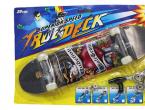Board game uno game rules. Uno rules in simple language. Uno gameplay
- UNO can be played with a company of 2 to 10 people. According to the rules, the game is intended for participants over 7 years old.
After each player has got 7 cards, the rest of the cards must be folded into a deck (face down) and placed in the center of the table. From this deck, each of the players will collect cards during the game itself.
Draw the topmost card from this deck to start the game. Turn it over and place it next to the deck. The game begins with this first card, now it is on this card that the rest of the players will put their cards to make a move.
The first player must choose from his cards the one that matches the card laid out in the center (they must be of the same color, OR of the same value, OR with the same symbol). Then the next player in the circle must play one of the cards, which will match the one that the previous player played (also in color, OR value, OR symbol). The next player also chooses one of his cards, which will coincide with the one played by the previous player (according to one of three signs). The next player then does the same, choosing a card that he can “make a move” with.
- For example, if the game starts with a red card numbered 8, you can in turn play either any red card OR a card of any color but numbered 8.
- Usually the game proceeds clockwise, starting from the player who dealt the cards and played the first card from the general deck as the starting deck. Players walk in a circle.
Advice: if a player in the course of the deal happens to be the lucky owner of a “change of color” card (a black card with an oval in the center with red, yellow, green and blue colors), he can use it for any of his moves, no matter what card the previous player played.
If you do not have a card in your hand that you could “make a move”, you take one of the general deck lying in the center of the table. If it is your turn to "walk", and you do not have a single card that matches the number or color of the previous player's card, take one card from the general deck. If it turns out to be the one that matches the number or color, you can "make a move" with the same card immediately after you took it from the deck.
- If this card also did not fit, you keep it for yourself, and the next player makes the move.
Pay attention to the active cards and the color change card. In addition to the usual Uno base cards, which are colored and numbered, there are also three types of so-called active cards in the game. The color change card gives the player the right to make a move, while setting a different color for the next player. If you play a +2 card, the next player draws 2 cards from the common deck and skips. If you play a change of direction card, you change the course of the game. The previous player who moved before you makes the next move.
- The change of direction map shows two arrows pointing in opposite directions.
- If you played a Skip Turn card with a circle crossed out, the next player behind you skips their turn.
Did you know? The card "change of color + 4 cards" can be played like the classic card "change of color", but with one addition: the next player will have to take 4 cards from the general deck and skip their turn.
If you have only one last card left, immediately say out loud:"UNO!" Players take turns until one of them has only one card left. As soon as this happened, the player who has the last card left must say the word "UNO" loudly. If he forgets about this, and the other player says "UNO" instead of him, the participant with the last card will have to take 2 more cards from the common deck as a penalty.
- If the participant, who has the last card left, forgets to say "UNO", he must take 2 more cards from the general deck as a penalty. But if he forgot to say "UNO", and none of the other players paid attention to it, penalty cards are not taken.
Discard the last card to win the round. As soon as you have the last card left (and you said "UNO"), wait until the queue returns to you again. If you manage to get rid of your last card before anyone else can, congratulations - you are the winner!
- If you failed to "throw out" the last card, take another one from the deck and continue the game until one of the players gets rid of all the cards.
- Try to keep the "color change" card for as long as possible so that it remains with you as the last one. That way, you'll be sure you can win by laying it out in almost any scenario when it's your turn to walk!
At the end of each round, you need to calculate the number of points scored for each player. Each of the players counts his points on the cards remaining in his hands, the loser is the one who scored the most points (that is, the one who has the maximum number of cards in his hand). In fact, you can start a new game after any completed round (see) But in the classic version of the game, points are calculated after each round for all players (the cards remaining in their hands are added), and then these points are awarded to the player who got rid of his cards first ... And the end of the game comes when one of the players gains 500 points - this is the winner of the game.
Uno is a miniature compact game for a company of two or more. It can be played from the age of seven, at home and on the road. The game is quite popular, with over 140 million copies sold worldwide.
Uno is a board game played with special cards. The game is fast and has simple rules. The number of players varies from two or more. The deck contains cards with numbers and different colors + several special cards with tasks to be completed. After the cards are dealt to the players, everyone tries to discard them as quickly as possible. Perfect for parties and table gatherings with friends, for playing on the road.
Uno rules



Purpose of the game uno
Discard your cards as quickly as possible and earn more points, leaving more cards in your opponents' hands.
Uno video game
How many cards are in the game uno
There are 108 cards in the deck. Of these:
- 76 digital cards;
- 24 active cards (three types of cards, each of four colors, two pieces);
- 8 black active cards (two types of four each).
Uno game cards
Digital cards- denomination from 0 to 9, different colors.

Active cards:

Black active:

Uno game reviews

Mini uno cosmostars
Miniature Uno Cards can be cut from Nesquik and Cosmostars boxes. The rules of the game can also be found there.
Where to print uno cards
slotobzor.com/karti/karty-uno-raspechatat
https://ja-rastu.ru/news-all/gam-devel/game-table/982-igra-uno-svoimi-rukami.html
The rules of the game are simple, the company can learn them within fifteen minutes or during the game. Uno will become a pleasant pastime with friends, will not let your logic and ingenuity degrade, and will help you have a good time in the company.
Instructions
The dealer shuffles the deck and puts 7 cards each. The rest of the cards are stacked face down in the "Buy" pile, and the top card from the "Buy" face down is laid out next to it - this will be the "Discard" pile.
The game is started by the person sitting to the left of the dealer. He must put in the "Discard" pile a card that matches the card in the discard pile by color, seniority, or value. Then the move goes to the next player.
If a card with the value "Opposite" is put into the "Discard", then the game changes direction, that is, the next will not be the player on the left, but the one on the right. This will be the case until the "Reverse" card is again put into the "Discard" card. You must be very careful not to get confused and not abuse your neighbor's sabotage. You’ll be lucky if you have the right cards in stock in case the move comes back to you.
If there is no suitable card on hand or the player does not want to spend it for some reason, then another card is taken from the "Prikup". If it fits, then it goes to "Discard", if not, then the move goes to the next one, and the player takes the taken card for himself.
In addition to "On the contrary" there are several active cards in the deck with different meanings, which you can pretty much "annoy" your opponents. "Take two" - that the next player must take two cards from the "Prikoka" in his hand at once. "Skip the move" - the move goes to the next one. "Order a color" - this one can radically change the course of the game. It is placed on a card of any value and at the same time a color that will be convenient for the player who placed it. And further in the course of the game, it will be considered that the "Reset" contains exactly the color that was named, until someone changes it again.
The coolest card is "Order a color and take four". It not only changes the color of the game, but also instructs the next player to take the extra four cards from the "Prikup", skipping, respectively, his turn.
The object of the game is to discard all cards. When one of the players has only one card in his hand, this is the most crucial, climactic moment. This player must shout "Uno!", "One". But if he forgets to do it, and someone catches him of gibberish and shouts "Uno!" instead, that player is penalized with a two-card penalty from Prikup. This is the salt of the game - you have to be completely concentrated, and monitor not only your cards and the course of the game, but also the number of cards your opponents have in order to be able to shout "Uno!" didn't break the rules.
Fines are imposed for violations. For example, you cannot prompt - the penalty is two cards from "Prikup". If a player is caught putting an unsuitable card, he must take it, take two more cards from the "Priku" and skip the turn. It is impossible to use the card "Order a color and take four" without a good reason, but only if you really do not have a suitable one on your hands. If the player has aroused suspicion, then he is obliged to show all his cards to the person whose move is next and who will be forced to take the extra four cards. Moreover, if the suspicions turned out to be in vain, the mistrustful neighbor is punished with two cards from "Prikup". But if his fears of the "setup" are confirmed, then the culprit himself takes four additional cards and misses his turn.
These are classic UNO rules. In the brochure enclosed with the game, you can find other variants of the game - together, in pairs. And also sophisticated methods like "UNO seven-zero", for example. If you decide to play this option, then every time a zero rolls out, all participants will have to give their cards to their neighbors in the direction of the game. And if a seven falls out, then the player who put it in the "Discard" exchange cards with any player of his choice.
UNO is a game for attention and reaction speed. Increase the pace of the game as you gain experience - to the maximum possible. When the period of mastering the rules is passed, the real battle begins. And, I must say, it is very addictive, and the benefits for the brain are tangible.
If you've never played UNO, do not know what the rules are there and have never heard what kind of game it is, then it's time to find out about it. Today we will tell you about Uno and the new competition.
For the first time I saw a strange card game, Austrian students were playing Uno, well, I played with them, you can learn in 2 hands. A lot of time has passed since then, and only now I bought a deck, for at least several trips the question “what to take with you on a trip” will be irrelevant for us.
The history of the game "Uno"
Wikipedia tells us that this game was patented in the USA, it was developed already in 1971 by a simple barber from Ohio. He drew the first deck at home, on the dining table, and they played for a long time with the whole family. The first homemade decks, Merle Robbins sold in his barber shop. The game became quite popular for their startup, the whole family raised $ 8,000 and released "Uno" with a circulation of 5,000 decks. Ten years after the game was created, Robbins sold the rights to it for $ 50,000 to one of Uno's fans, plus a 10-cent commission on every deck he released.
Cards in the deck
Playing cards +2 (take two cards) and +4 (take four and choose a color) add intensity.
The player next to you draws 2 or 4 cards and skips his turn.
You can also change the direction of the circle by using “reverse”.
With "color" you can choose any color ...
And make the player next to you skip the turn with the "rest" card.
The rest of the deck is four zeros of different colors and cards in denominations from 1 to 9 in duplicate.
Uno rules
For those who have not yet understood what the beauty of this game is, here, for your reference, the rules of the game.
The main condition for victory: you need to get rid of all your cards. There are 108 of them in the deck.
At the beginning of each draw, 7 cards are dealt to the players. Draw structure is simple, you put the cards according to color and order, for example: 7 yellow - 5 yellow - 5 green - 5 red - 0 red - "color": blue - 9 blue - 3 blue ...
If you do not have the required card (triplets or blue cards), then you take one of the deck, if you get a suitable one - put it, if not, then the next player goes. You can also hold on to strong playing cards until just right.
Take-four card and investigation
Playing card +4 can only be played if you have no color cards left (or cheat a little). Perhaps you think that the player who laid this card played dishonestly and has cards of the desired color - then you can arrange a "check", the cost of which is +2 cards in your hands if he played fair and +4 for the "suspect" if he is everything. -so played unfairly.
Uno's rule
An interesting rule is itself the word "Uno!"(from the Italian "one" - uno), it must be said before you put the penultimate card on the table and you will have only one in your hand. Some are so impatient to get rid of all the cards that they forget to say the "magic" word. If other players catch you doing this and say "Uno" instead of you, then fine will be two cards into your arms. They may not even notice this and you will not receive any fine.
When one of the players discards all cards, the others count the value of the cards in their hands. I will give a table here:
- Cards from 0 to 9 - respectively, from 0 to 9 points;
- Reverse card - 20 points;
- Card "pass the move" - 20 points;
- Take 2 card - 20 points;
- Color card - 50 points;
- Take 4 card - 50 points;
All counted points are added to the winner's asset and he wins the whole game with 500 points. Many players refine the game and develop their own rules, which you can do too. Examples of such rules:
- Give the card “Reverse” additional power, and if one player has put +2, then you can fight back with “reverse” and then the previous player will take two cards, and you will continue to move.
- Make "+2" or "+4" cards cumulative and if you play them in a row, the next player will take twice as many cards.
Instructions for Uno in English, with all the errors of Chinese translators.
World championship
This game is great for large groups of people (although you can play together), there are even annual international championships in different countries. If in regular games the winner is the one who first collects 500 points, then in the tournament the knockout game will be more interesting and those who collect 500 points are automatically eliminated. Look how fun this game is, here is a video from the championship.
New Year's competition "UNO"
If you liked the game, then you can get your deck for playing UNO completely free of charge from us, because we are in a very Christmas mood to give gifts. We will send 1 more deck to one of our subscribers, who will place an order from 100 RMB per Taobao with the help of a new group
Board game
Number of players
From 2
Party time
From 15 minutes
Difficulty of the game
Average
Uno - an addicting American card game... This board game was patented by Merle Robbins in 1971. Its trademark rights are today held by Mattel.
Target in the board game Uno
- The card game ends when the participants run out of cards, or there is no necessary one, and the main deck is over. The main goal is to fold the cards and count the points on the cards remaining in your hand.
Card Uno: the rules of the game
Preparing to play Uno
- The game deck consists of 108 cards, there is also a deck of 112 cards, which contains empty cards.
- Cards are used in four colors - yellow, red, blue and green, have numbers from 0 to 9, of which 76 pieces, two for each color from 1 to 9, and one set of cards with number 0) are ordinary cards.
- There are cards denoting actions - these are 8 cards "Take two", 8 cards "Reverse" 8 cards "Pass the move" also two cards per color. Another action card is 4 Color Order cards, 4 Take Four cards depicted on a dark background.
- The deck also contains four white cards labeled "Empty", which are used to replace lost cards, or to introduce new rules.
Uno gameplay
- From the very beginning, the dealer is determined in the game, this happens by drawing a card from the deck by all participants, who will draw the biggest one and become the dealer. When the competitor has drawn one of the action cards, he must draw the card again. If several people have drawn a large card, the selection must also be made again.
- After determining the choice, the dealer starts dealing six cards each. The card of the deck, which is located on top, lies with the picture up and it is from it that the game starts, it gives rise to the game deck. If this card indicates actions, then it changes to another.
- In the case when the player has put the +2 card, he will be able to transfer the move to another player, while putting another +2 card.
- The game is played clockwise.
- With each move, the player puts a card into the deck, while it must match in color or picture with the top card of the deck. If the player does not have the required card, he can take a new card from the deck, and when it comes up, then it can be made a move. But of course, you can and not make this move for this you will not receive any penalty. When a participant has a card with a black background, he can make a move to it even without looking at the card that is on top of the deck.
- When the participant of the game puts his penultimate card into the deck, he must shout "Uno", while he must have time before the other player puts his card. If he does not have time to utter the coveted phrase, he immediately takes four new cards from the deck.
- If the player puts the last card he has in the deck, one point is added to his account, and then he draws 6 more cards.
The meaning of action cards
- "Empty" cards are used to introduce new rules (they are not available in new versions of the game);
- Card "Take 2" - the next participant of the game takes 2 cards from the deck of the bank;
- Card "Reverse" - change the direction of the move;
- Card "Skip turn" - the player who put the card again makes a move. When he has two identical cards, they can also be used as a turn pass;
- “Wild” card - a participant can order a color for another player, and he needs to make a move with a card of this color, or with a black card.
- Card "Wild + four" - again the player names the color, and the next one, in addition to the above actions, takes more cards from the deck. It can be beaten with a + 2 card.
Penalties
- When a player forgets to say the word "Uno", when he has already put his penultimate card, and it is noticed, they put their finger on this participant and say "Uno". Then the player takes two cards from the deck.
- The player who made a recommendation for another about which card he needs to play, he must also take two additional cards.






